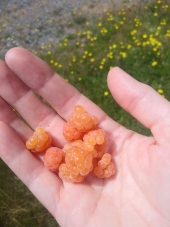posted 3 years ago
I get some interesting ideas will come out of this discussion.
My number one harvesting "tool" is the thumb nail on the right hand. I purposely leave this fingernail a bit long and cut on an angle so that I can use it as a harvesting knife for leafy greens. I too harvest most leafy greens one leaf at a time. The thumb nail works fine enough for everything but the thicker bok choys. I’m harvesting weekly, so the leaves are quite young. No tough stems. But if I leave a lettuce plant to form a head, then I slice it off above ground level using a box cutter knife.
Scissors work for me harvesting some things……those things that my thumb nail can’t handle.
Tomatoes— the varieties I’m growing are quite easy to pluck. No tools required.
Eggplants, peppers — a twist of the fruit and a snap does the trick for me.
Pumpkins and gourds, usually a bending back + snap motion does it, but if I want to be sure to leave a long handle, then I use a pruning shears in order to leave a long stem for carrying purposes.
Sweet potatoes and peanuts— we are using a fork at the moment. We are not happy with that method. So we want to fashion some sort of subsurface chisel plow thingy to help lift the tubers and soil so that we can go back and harvest by hand. We could drag the subsurface lifter with either the rototiller (without the tines) or an ATV. We will try working on this idea in the future.
Potatoes —- we harvest at 3 months, so the soil hasn’t gotten too hard for using our hands. So we just feel around for the tubers. We miss a few, but they show up when we till in the compost for the next crop.
Herbs — we use our fingers for the ones that we pluck, such as basil, dill, parsley, etc. Those with tougher stems we use scissors, such as oregano, mints, rosemary.
Daikon, carrots, parsnip — most can be harvested by pulling. Sometimes we need to loosen them up a bit. We have a giant old screwdriver that works well. Some sort of small breaker bar would probably work well.
Cucumbers — mostly hand plucked, but sometimes the stem is too tough. I always have one of those snap-blade boxcutters in my pocket and they come in handy for those tough cucumber stems.
Chayote — hand picked. The vines run up a trellis, which actually is a dead tree. I just yank the stem down until the chayote either falls off or it is within reach to grab. Some day I’ll get around to making a bamboo trellis, but I haven’t gotten there yet. That way the chayotes would be within reach just above my head.
Beans and peas — hand plucked
Beets, onions, turnips, rutabagas — hand yanking does the trick
Fruit trees — most trees we have pruned short enough that a hand picking pole is needed only for the higher branches. The 2/3 lower parts of the tree are within hand plucking reach. Quite truthfully, I’m not going to risk running up a ladder to reach a few fruits and risk hurting myself. Around here I know of folks who have broken wrists, ankles, shoulders, arms, collar bones, and cracked their skulls. They torn muscles, ligaments, rotator cuffs. They have permanently injured their backs. Naw, not worth it. Chop the trees shorter! Less fruit, but also less injuries.
Pineapples — a snapping motion does it.
Bananas — we make cuts on the trunk so that it acts as a hinge. With a little persuasion, the weight of the banana bundle slowly lowers itself to the ground without crashing.
It's never too late to start! I retired to homestead on the slopes of Mauna Loa, an active volcano. I relate snippets of my endeavor on my blog : www.kaufarmer.blogspot.com


 5
5




 5
5




 5
5




 5
5




 7
7




 1
1




 3
3




 2
2




 3
3




 1
1





 2
2












